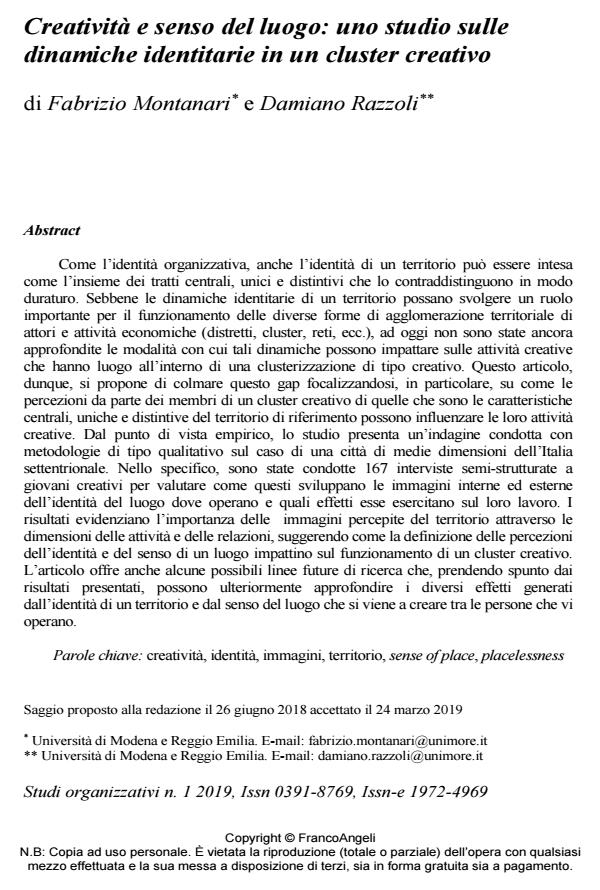Creatività e senso del luogo: uno studio sulle dinamiche identitarie in un cluster creativo
Titolo Rivista STUDI ORGANIZZATIVI
Autori/Curatori Fabrizio Montanari, Damiano Razzoli
Anno di pubblicazione 2019 Fascicolo 2019/1
Lingua Italiano Numero pagine 33 P. 64-96 Dimensione file 548 KB
DOI 10.3280/SO2019-001003
Il DOI è il codice a barre della proprietà intellettuale: per saperne di più
clicca qui
Qui sotto puoi vedere in anteprima la prima pagina di questo articolo.
Se questo articolo ti interessa, lo puoi acquistare (e scaricare in formato pdf) seguendo le facili indicazioni per acquistare il download credit. Acquista Download Credits per scaricare questo Articolo in formato PDF

FrancoAngeli è membro della Publishers International Linking Association, Inc (PILA)associazione indipendente e non profit per facilitare (attraverso i servizi tecnologici implementati da CrossRef.org) l’accesso degli studiosi ai contenuti digitali nelle pubblicazioni professionali e scientifiche
Come l’identità organizzativa, anche l’identità di un territorio può essere intesa come l’insieme dei tratti centrali, unici e distintivi che lo contraddistinguono in modo duraturo. Sebbene le dinamiche identitarie di un territorio possano svolgere un ruolo importante per il funzionamento delle diverse forme di agglomerazione territoriale di attori e attività economiche (distretti, cluster, reti, ecc.), ad oggi non sono state ancora approfondite le modalità con cui tali dinamiche possono impattare sulle attività creative che hanno luogo all’interno di una clusterizzazione di tipo creativo. Questo articolo, dunque, si propone di colmare questo gap focalizzandosi, in particolare, su come le percezioni da parte dei membri di un cluster creativo di quelle che sono le caratteristiche centrali, uniche e distintive del territorio di riferimento possono influenzare le loro attività creative. Dal punto di vista empirico, lo studio presenta un’indagine condotta con metodologie di tipo qualitativo sul caso di una città di medie dimensioni dell’Italia settentrionale. Nello specifico, sono state condotte 167 interviste semi-strutturate a giovani creativi per valutare come questi sviluppano le immagini interne ed esterne dell’identità del luogo dove operano e quali effetti esse esercitano sul loro lavoro. I risultati evidenziano l’importanza delle immagini percepite del territorio attraverso le dimensioni delle attività e delle relazioni, suggerendo come la definizione delle percezioni dell’identità e del senso di un luogo impattino sul funzionamento di un cluster creativo. L’articolo offre anche alcune possibili linee future di ricerca che, prendendo spunto dai risultati presentati, possono ulteriormente approfondire i diversi effetti generati dall’identità di un territorio e dal senso del luogo che si viene a creare tra le persone che vi operano.
Parole chiave:Creatività, identità, immagini, territorio, sense of place, placelessness
Fabrizio Montanari, Damiano Razzoli, Creatività e senso del luogo: uno studio sulle dinamiche identitarie in un cluster creativo in "STUDI ORGANIZZATIVI " 1/2019, pp 64-96, DOI: 10.3280/SO2019-001003